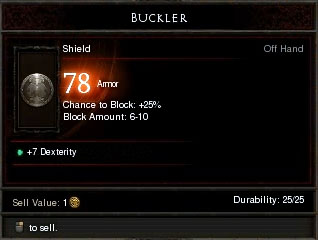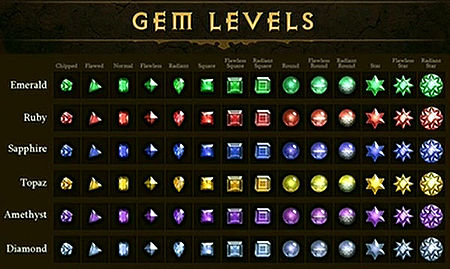Gem
Gems return in Diablo III, and they're set to be a much larger part of the game. The item type works just as it did in Diablo 2; Gems are still small objects that have no function on their own, which add various bonuses when placed in item sockets. The bonuses they grant have changed though, and there are many more quality levels of gems (14 in D3, vs. 5 in D2).
They can still be upgraded in a 3<1 ratio, though that process requires the Jeweler, rather than the Horadric Cube, and it's widely suspected that gems will be used in more than items, with a use in the Talisman perhaps making them even more valuable.
- Information about Gems in Diablo II.
Contents
Diablo III Gems
Gems in Diablo 3 have evolved during the game's development. Early on, they were similar to World of Warcraft gems, with a "cut" listed in their properties. For instance, a "chipped star topaz" was seen in an early gameplay movie.
This feature was removed over time, and as of late 2010 gems are much closer to how they were in Diablo 2; no "cut" is listed, and they simply have quality levels; 14 of them (compared to 5 in Diablo 2).
Gems grant varying bonuses when socketed into items of all types, and they might have other functions, such as use in crafting recipes.
Twinking Gems
Gems do not have a Clvl requirement to use, and they are intended to be very useful as twinked items. [1]
There may be some interesting complications with this though.
Gem Types
A graphic was shown at the Crafting Sanctuary panel at Blizzcon 2010 that displayed six types of gems: Rubies, Sapphires, Emeralds, Topazes, Amethysts and Diamonds.
Skull gems were not shown, and they have not been seen in the game. Skulls, or other types of gems, may be in the game and not revealed yet, or might be added in expansion packs.
Gem Levels
The naming convention for gems in Diablo III is similar to how it worked in Diablo II. The first four levels are the same, with "radiant" replacing "perfect" for the fifth level. After the first five there are square, round, and star gems that repeat the top three quality levels.
- Level 1 - Chipped
- Level 2 - Flawed
- Level 3 - Normal
- Level 4 - Flawless
- Level 5 - Radiant
- Level 6 - Square
- Level 7 - Flawless Square
- Level 8 - Radiant Square
- Level 9 - Round
- Level 10 - Flawless Round
- Level 11 - Radiant Round
- Level 12 - Star
- Level 13 - Flawless Star
- Level 14 - Radiant Star
Upgrading Gems
Gems upgrade in D3 just as the did in D2. Three of one level will combine into one of the next level.[2] This is accomplished by taking the gems to the Jeweler, rather than simply doing it yourself with a Horadric Cube, but the function is the same.
One improvement over Diablo 2 is that gems of like type/level will stack up to 10 high[3] in a single inventory space. Players will thus not sacrifice so much space for gem storage.
Gems can be found at levels 1-5, and with a maximum level of 14, the process of upgrading a gem all the way to the top should be a very long term project. If the current 3>1 upgrading ratio remains unchanged, then it would require 1,594,323 level 1 gems to make a single level 14 gem (3^(14 - 1)). To give you an idea how long this would take, just upgrading the gems that many times would take 664 hours of nonstop clicking, assuming you could complete one upgrade per second.

The math isn't quite as daunting if you assume you'll be upgrading level 5 gems; it only requires 19,683 level 5 gems to make one level 14 gem. Happily, Jay Wilson has said that they're open to tweaking the formulae if it's taking too long; instead of 3>1 they might turn it down to 2>1 at higher levels, as was done with higher level Runes in Diablo II. It would only require 512 L5 gems to upgrade to a L14, if the requirement was 2>1 all the way up.
In August 2010 Bashiok spoke on the design theory behind high level gems taking so long to create.[4]
Also the trading game and millions of people playing for months is going to make them a lot more attainable than they may seem when throwing out numbers like 19,000.
It’s possible it may feel crappy or we need to add something to help jump gaps, or, who knows. It’s all very unproven at the moment, but we think provides a nice long term goal anyone can work toward just by killing monsters and picking up gems.
Creating and Spending Gems
It also sounds as if the Jeweler will have a way to create gems, judging from his description in the Caravan FAQ.
- The jeweler crafts gems, amulets, and rings. The jeweler can also remove gems from socketed items and can combine gems to improve their quality.
What, "crafts gems" means isn't yet known, but if materials can be spent to create new gems, that could radically change the time table for crafting up top level gems.
Bashiok alluded to other gem purposes as well, in a forum post in August 2010. [5]
Unsocketing Gem
One key fact to consider is that in Diablo III, gems (and other socketables) can be removed from sockets, by the Jeweler, without losing the gem or the item. (Though this may grow quite expensive[6] with higher level gems.) This was not the case in Diablo II, where runes, gems, and jewels were in an item forever, or were destroyed by the unsocket recipe. This change fundamentally alters the upgrading project, since instead of gems sitting useless in your stash until they are all the way to the top level (as they did in Diablo 2), characters in Diablo III will be using their highest level gems all the time, and gaining considerable benefits from the gem.
If a character's goal is to gain a huge bonus from a L14 gem in their shield, they'll be using that type of gem at L9, L10, L11, and so on, as they slowly upgrade it towards L14. This should make the upgrading process seem a little less lengthy, especially as it will take weeks or months for each additional level of improvement with a high level gem.
Gem Bonuses
Little is yet known of the bonuses gems will provide. It's widely-assumed that the higher level gems will grant very high bonuses, and that the bonuses won't simply increase at say, +3 per level. That doesn't seem like enough of an improvement to make the months and months of collecting and upgrading required to create a L14 gem worth it.
As for what the gems will provide bonuses to, that's also unknown. Jay Wilson commented on this from Gamescom 2010:
- in.Diablo.d3: Can you tell us about gem stats?
- Jay Wilson: They work much as they did in D2. They have fixed stats depending on which type of item you put them into. We largely copied what D2 did, but not exactly since our itemization is different and stating is different. For example, most of our classes don’t have mana, so that wouldn’t work. But things like casting speed and strength and such are there.
Known Gem Bonuses
The only officially confirmed gem stats were seen on a normal (level 3) Emerald, in the Gamescom 2010 Artisan video. That gem granted:
- Weapon: +4% Casting Speed.
- Helms: Attackers take 7 damage.
- Other: +7 dexterity
In the Diablo 2 expansion, a level 3 emerald grants:
- Weapons: 17 poison damage over 1 second
- Armor & Helms: +6 dexterity.
- Shields: +22% Poison Resistance
- Clvl 12 required for all
The numerical bonuses (but not the type of bonus) from gems changed from D2C to D2X, but clearly there are major differences in more than the numbers. Diablo 3 grants entirely different types of bonuses, and categorizes the socketable items differently as well; helms/armor no longer share the same bonuses.
These changes are largely due to the game's different combat mechanics and character requirements, but were also somewhat required by the different itemization issues. For instance, Sapphires in helms/armor grant +mana in Diablo 2, but +mana isn't a viable bonus in Diablo 3, since only the Witch Doctor has mana for a resource. Even considering that, the changes to the Emerald are quite large. In Diablo 2, most gems provided resistance in shields and elemental damage in weapons. Emeralds in D3 do neither of those things.
Unofficial gem stats
Recently a few more gems we're discovered through ninja photos of the Blizzcon 2010 build. Note that this build still used the old attributes, and that all of these gems have probably been updated to the new attributes in the latest build.
Chipped (level 1) Ruby granted:
- Weapon: Spells deal 10% more damage
- Helm: +2% Chance to Block
- Other: +2 Strength
Flawed (level 2) Amethyst granted:
- Weapon: +0,03 Attacks Per Secound
- Helms: +3% Movement Speed
- Other: +2 to all Attributes
Flawed (level 2) Sapphire granted:
- Weapon: +3% Life Stolen per Hit
- Helm: 3% Better Chance of Finding Magical Items
- Other: +4 Willpower
As you can see, a level 1 Ruby grants +2 Strength, while a level 2 Sapphire grants +4 Willpower and a level 3 Emerald (as seen in the Gamescom 2010 Artisan video) grants +7 Dexterity.
It is possible that it is always a 75% increase in an attribute per level of the gem, and that the +2 from the Chipped Ruby is increased by 75% to 3,5 on the Flawed Sapphire and then rounded (to the closest number without a decimal) to an even 4. The +4 from Flawed Sapphire increased by 75% equals 7, like we can see on the Emerald. All of this is pure speculation and highly likely to change, since itemisation is one of the last things that gets done in the development of the game.
But it is an intressting thought, and if this theory holds true, then a maxed out Radiant Star (level 14) Ruby (or any gem that increses an attribute, I am just using a Ruby as an example) would give +3287 Strength if it was socked into something other than a weapon or a helm, which is a massive upgrade from the Flawless Star (level 13) Ruby that would "only" give 1878 Strength.
| Items of Diablo III [e] Item Basics Normal Items Crafting Legendary Armor I Legendary Armor II Legendary Weapons 1h Legendary Weapons 2h Item Sets |
|---|



